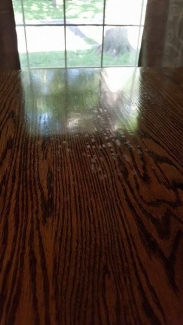

This is a guesstimate as GF cannot assist with the performance of another manufacturer's product used in conjunction with our own finishes.
It looks like Annie Sloan Chalk Paint is absorbing some of the topcoat because it is so porous. High Performance does not streak over a sealed surface when properly applied. Most likely the chalk paint is so dry it is pulling some of the solvents away from the High Performance, causing an uneven finish or the appearance of streaking. This happens on the original powder Chalk or Milk Paints also.
Water Based Stains will always exhibit a bit of bleed through. When glazing with any color over water stains, we recommend some type of seal coat is applied first.
All bright white paint will yellow slightly with time, even without topcoat. You have probably tried to touch up white woodwork in your home after several years and noticed that the new paint is brighter.
But white and light paints can react if clear coated with a waterbased finish; water-based topcoats are reactive and may draw out substances in the wood such as tannins, dyes or unknown substances in existing finishes causing the topcoat to yellow. This is an industry-wide issue and can happen right away, years later or never.
It is normal to see a bit of stain on the brush when applying the first coat of topcoat. Topcoats often pull a bit of color on the first pass, but good preparation will minimize this.
To prepare open grains woods such as raw Oak for a water-based stain, we recommend sanding with 180-grit followed by no more than 220-grit sandpaper.
The word "latex" is often a misnomer and is used everywhere to differentiate a water-based product from an oil-based product. The same as the word “Kleenex” is used to describe any type of facial tissue, regardless of the brand.
Today, "latex" is the technical term for a suspension (U.S.) or emulsion (European) of microparticles in water.

The problem areas on your table are probably caused by surface contamination from oils, waxes or cleaning products used over the years.
Contaminants from dusting sprays that contain silicone will also impact the appearance and adherence of a finish - silicone is almost impossible to remove. Oil soaps and wax can also cause adhesion failures. This may be why the finish is performing differently on the leaves vs the table top. Adhesion failure is often more obvious in the deepest patterns of grain because the contamination is driven deep into the grain.
GF advises extra care and prep when applying any finish over laminate surfaces because they are specifically designed not to mar and therefore they are not very "sand-able", making adherence difficult.
In addition to this non-permeable surface factor, General Finishes Gel Stain is an oil-based product, and it is more difficult to obtain proper drying characteristics over a dense manufactured surface such as laminate. Gel stains, as all wood stains, were formulated to go over raw wood which has an "open" surface and can absorb some of the stain.
Hazing or a cloudy appearance can occur when applying a super matte finish over dark colors. In the paint industry, we call this DOI – Distortion of Image. The waxes that give Flat Out Flat its soft feel and the additional matting agents in the formula do not allow light waves to completely refract outward when used over dark colors. Plus, dark colors naturally absorb more light. DOI does occur over light colors, you just can’t see it. Best practice is to always test your finishing schedule before completing the entire project to make sure it meets YOUR satisfaction.
Gel Stain gets its deep rich hue from a large amount of colorants. Seal the stain with a topcoat before applying glaze to prevent "color pull" when applying glaze.
Flat Out Flat is a matte water based topcoat with a velvety feel and was developed as a durable alternative to our Satin Wax.
Choose this product if you want a finish that looks more like wax and your project will not require high use. Like wax, it dries softer to the touch than High Performance when completely cured, and it will show more marring and fingerprints. Flat Out Flat is made with a stable self cross-linking acrylic instead of urethane.